Boletus L.
Recent molecular studies have shown that Boletus in its current circumscription is likely an artificial grouping and it is possible that it will be split at some point into smaller genera. Note that Boletus impolitus and Boletus depilatus for practical reasons are retained here, although there is strong evidence that they are closely related to Xerocomus subtomentosus and its allies.
Fruitbody large to medium sized, boletoid, without veil and ring. Stipe solid, with surface usually covered with granules or network. Flesh variously coloured, changing or not when exposed to air. Tubes easily separable from each other, not tearing apart. Pores usually small and rounded.
Boletus luridus Schaeff. : Fr.
Description
Cap up to 15 cm, at first hemispherical, later convex to flat-convex, yellowish, yellow, olivaceous yellow, greyish yellow, greyish ochraceous, olivaceous grey, sometimes with darker spots, yellow with pinkish or flesh-coloured areas or almost entirely flesh coloured, or red, cap surface blueing when bruised. Stipe club-shaped, swollen or cylindrical, often rooting, in the upper part most often cream or pale to bright yellow, downwards red or pale vinaceous to vinaceous, with more or less developed orange red, red or vinaceous red network, stipe surface blueing after handling. Flesh initially lemon yellow, later whitish in the cap and lemon yellow in the stipe, rarely dirty whitish throughout, in the stipe base dark red, vinaceous, reddish purple or purplish brown, quickly blueing when exposed to air; the flesh under the tubes orange red, red to vinaceous. Tubes initially lemon yellow, then yellow with olivaceous tint, blueing when injured. Pores orange, orange red or bright red, sometimes paler towards the cap margin, blueing when bruised. Smell not distinctive. Taste acid. Spores 10.5–15.5 × 4.5–7 μm, ratio 1.8–2.8. Pileipellis (the cap cuticle) trichodermium of interwoven septate hyphae of cylindrical, finely incrusted cells. Chemical reactions: hyphae of the flesh in the stipe base strongly amyloid with Melzer’s reagent.
Habitat. Broadleaf, mixed and coniferous forests, gardens and parkland, mycorrhizal with oaks (Quercus), beech (Fagus), sweet chestnut (Castanea), hornbeam (Carpinus), birch (Betula), hazel (Coryllus), hop-hornbeam (Ostrya), lime (Tilia), poplars (Populus), spruce (Picea), fir (Abies), pines (Pinus), juniper (Juniperus) or rockroses (Cistus, Helianthemum).
Distribution. In Europe widespread and common.
Similarity. Boletus luridus differs from all the other European boletes on the account of the vinaceous, red or orange red flesh under the tubes when these are removed. Compare more closely with Boletus queletii, which has yellow flesh under the tubes and does not have network on the stipe.
Variability. Extremely variable and few infraspecific taxa are sometimes recognized:
var. rubriceps (Maire) Singer – with entirely red cap;
var. erythroteron (Bezdek) Pilát & Dermek – with cherry coloured flesh;
f. lupinus Peltereau ex Gilb. – with bright yellow cap, otherwise coloured as the typical forms;
f. primulicolor Simonini – with entirely yellow fruitbody, incl. the pores; see also Boletus gabretae.
Photographs

Typical fruitbodies of Boletus luridus. (photo M. Mikšík)

Fruitbodies of Boletus luridus. Note the chromatic variability. (photo B. Assyov)

Fruitbodies of Boletus luridus. Note the chromatic variability. (photo B. Assyov)
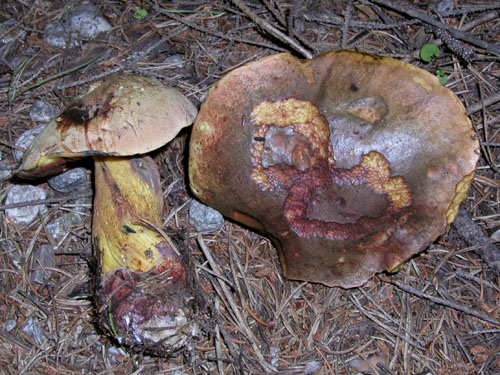
Fruitbodies of Boletus luridus. Note the chromatic variability. (photo B. Assyov)
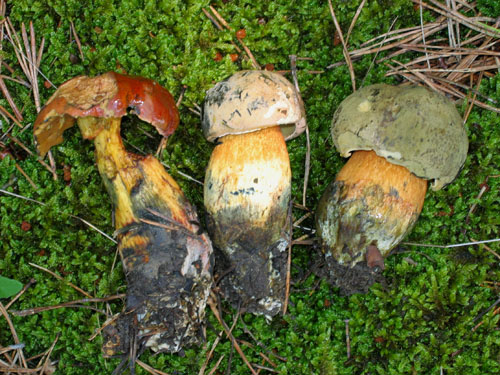
Fruitbodies of Boletus luridus. Note the chromatic variability. (photo B. Assyov)

Young fruitbody of Boletus luridus. (photo B. Assyov)
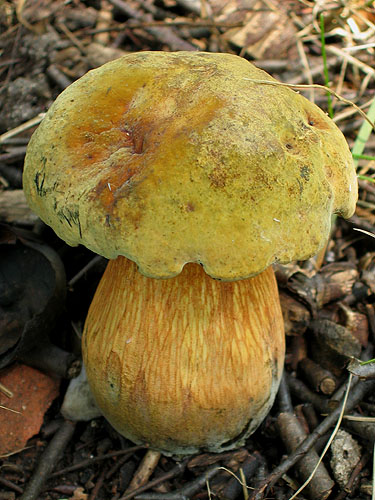
Young fruitbody of Boletus luridus. (photo B. Assyov)
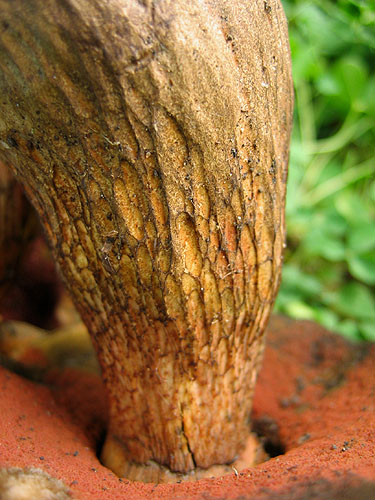
Boletus luridus - detail of the network on the stipe surface. (photo B. Assyov)
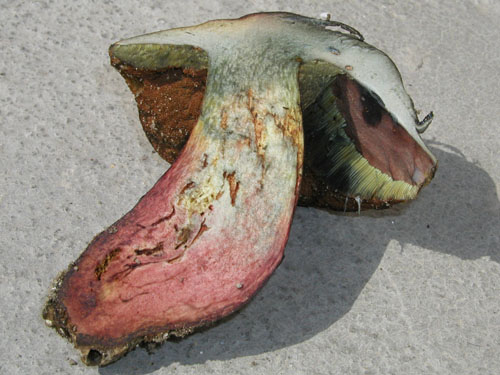
Cross section of fruitbody of Boletus luridus. Note the vinaceous colour of the flesh in the stipe base, the blueing and the colour of the surface, where the tubes are removed. (photo B. Assyov)
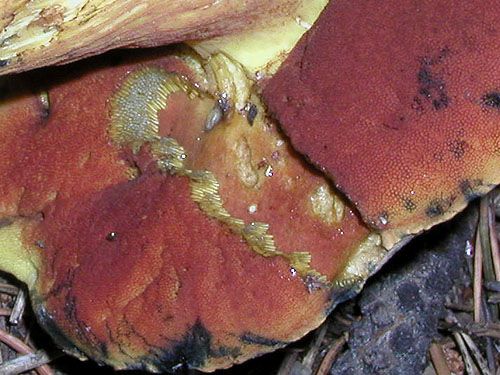
Boletus luridus - the typical red colour of the surface where the tubes are removed. (photo B. Assyov)
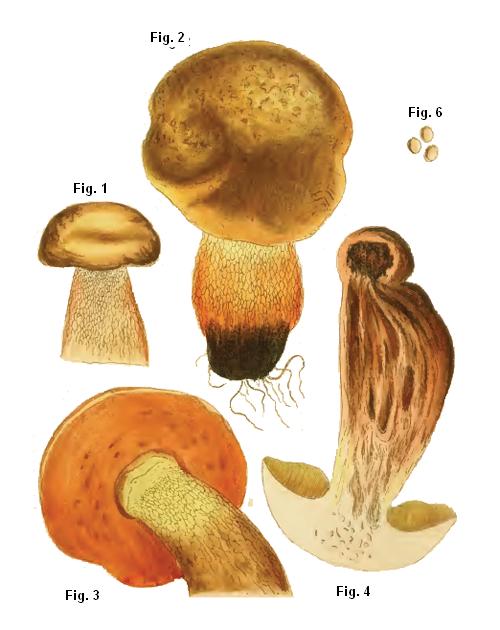
Part of the drawings of Boletus luridus accompanying Schaeffer's original description of the species. Figures numbers replaced with contemporary font to facilitate reading.

Boletus luridus - spores. Scale bar = 10 μm. (photo B. Assyov)
Important literature
Alessio, C.L. 1985. Boletus Dill. ex L. (sensu lato). – In: Fungi Europaei. Vol. 2. Pp. 1–705. Libreria editrice Biella Giovanna, Saronno.
Breitenbach J. & Kränzlin F. 1991. Pilze der Schweiz. Bd. 3(1). Röhrlinge und Blätterpilze. Verlag Mykologia, Luzern.
Engel, H., Krieglsteiner, G., Dermek, A. & Watling, R. 1983. Dickröhrlinge. Die Gattung Boletus in Europa. Verlag Heinz Engel, Weidhausen b. Coburg.
Estadès, A. & Lannoy, G. 2004. Les bolets européens. – Bulletin Mycologique et Botanique Dauphiné-Savoie 44(3): 3–79.
Hansen, L. & Knudsen, H. 1992. Nordic Macromycetes. Vol. 2. Polyporales, Boletales, Agaricales, Russulales. Nordsvamp, Copenhagen.
Galli, R. 1998. I Boleti. Atlante pratico-monographico per la determinazione dei boleti. Edinatura, Milano.
Knudsen, H. & Vesterholt, J. [eds.]. 2008. Funga Nordica. Nordsvamp, Kopenhagen.
Lannoy, G. & Estadès, A. 2001. Les Bolets. Flore mycologique d’Europe. Documents Mycologiques Mémoire Hors série no. 6. Pp. 1–163. Association d’Écologie et de Mycologie, Lille.
Muñoz, J.A. 2005. Boletus s. l. – In: Fungi Europaei. Vol. 1. Pp. 1–951. Edizioni Candusso, Alassio.
Pilát, A. & Dermek, A. 1974. Hríbovité huby. Československé hríbovité a sliziakovité huby (Boletaceae – Gomphidiaceae). Veda, Bratislava.
Singer, R. 1967. Die Röhrlinge. II. Die Boletoideae und Strobilomycetaceae. – In: Die Pilze Mitteleuropas. Vol. 6. Pp. 1–151. Julius Klinkhardt Verlag, Bad Heilbrunn.
Šutara, J., Mikšík, M. & Janda, V. 2009. Hřibovité houby. Čeled’ Boletaceae a rody Gyrodon, Gyroporus, Boletinus a Suillus. Academia, Praha.
Watling, R. 1970. Boletaceae, Gomphidiaceae, Paxillaceae. – In: Henderson, D.M., Orton, P.D. & Watling, R. [eds]. British fungus flora. Agarics and Boleti. Vol. 1. Royal Botanic Garden, Edinburgh.
Watling, R. & Hills, A.E. 2005. Boletes and their allies (revised and enlarged edition). – In: Henderson, D.M., Orton, P.D. & Watling, R. [eds]. British Fungus Flora. Agarics and boleti. Vol. 1. Royal Botanic Garden, Edinburgh.